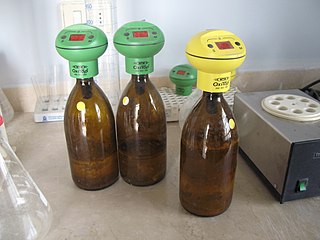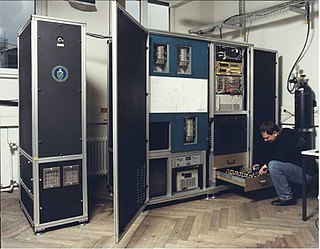Related Research Articles

Water quality refers to the chemical, physical, and biological characteristics of water based on the standards of its usage. It is most frequently used by reference to a set of standards against which compliance, generally achieved through treatment of the water, can be assessed. The most common standards used to monitor and assess water quality convey the health of ecosystems, safety of human contact, extend of water pollution and condition of drinking water. Water quality has a significant impact on water supply and oftentimes determines supply options.
Chemometrics is the science of extracting information from chemical systems by data-driven means. Chemometrics is inherently interdisciplinary, using methods frequently employed in core data-analytic disciplines such as multivariate statistics, applied mathematics, and computer science, in order to address problems in chemistry, biochemistry, medicine, biology and chemical engineering. In this way, it mirrors other interdisciplinary fields, such as psychometrics and econometrics.

An automated analyser is a medical laboratory instrument designed to measure different chemicals and other characteristics in a number of biological samples quickly, with minimal human assistance. These measured properties of blood and other fluids may be useful in the diagnosis of disease.

Biochemical oxygen demand (BOD) is the amount of dissolved oxygen (DO) needed by aerobic biological organisms to break down organic material present in a given water sample at certain temperature over a specific time period. The BOD value is most commonly expressed in milligrams of oxygen consumed per litre of sample during 5 days of incubation at 20 °C and is often used as a surrogate of the degree of organic pollution of water.

A data logger is an electronic device that records data over time or in relation to location either with a built in instrument or sensor or via external instruments and sensors. Increasingly, but not entirely, they are based on a digital processor, and called digital data loggers (DDL). They generally are small, battery powered, portable, and equipped with a microprocessor, internal memory for data storage, and sensors. Some data loggers interface with a personal computer, and use software to activate the data logger and view and analyze the collected data, while others have a local interface device and can be used as a stand-alone device.
An oxygen sensor (or lambda sensor, where lambda refers to air–fuel equivalence ratio, usually denoted by λ) is an electronic device that measures the proportion of oxygen (O2) in the gas or liquid being analysed.

Total organic carbon (TOC) is the amount of carbon found in an organic compound and is often used as a non-specific indicator of water quality or cleanliness of pharmaceutical manufacturing equipment. TOC may also refer to the amount of organic carbon in soil, or in a geological formation, particularly the source rock for a petroleum play; 2% is a rough minimum. For marine surface sediments average TOC content is 0.5% in the deep ocean, and 2% along the eastern margins.

The eddy covariance technique is a key atmospheric measurement technique to measure and calculate vertical turbulent fluxes within atmospheric boundary layers. The method analyses high-frequency wind and scalar atmospheric data series, gas, energy, and momentum, which yields values of fluxes of these properties. It is a statistical method used in meteorology and other applications to determine exchange rates of trace gases over natural ecosystems and agricultural fields, and to quantify gas emissions rates from other land and water areas. It is frequently used to estimate momentum, heat, water vapour, carbon dioxide and methane fluxes.
A particle counter is used for monitoring and diagnosing particle contamination within specific clean media, including air, water and chemicals. Particle counters are used in a variety of applications in support of clean manufacturing practices, industries include: electronic components and assemblies, pharmaceutical drug products and medical devices, and industrial technologies such as oil and gas.
Respirometry is a general term that encompasses a number of techniques for obtaining estimates of the rates of metabolism of vertebrates, invertebrates, plants, tissues, cells, or microorganisms via an indirect measure of heat production (calorimetry).
Moisture analysis covers a variety of methods for measuring moisture content in solids, liquids, or gases. For example, moisture is a common specification in commercial food production. There are many applications where trace moisture measurements are necessary for manufacturing and process quality assurance. Trace moisture in solids must be known in processes involving plastics, pharmaceuticals and heat treatment. Fields that require moisture measurement in gasses or liquids include hydrocarbon processing, pure semiconductor gases, bulk pure or mixed gases, dielectric gases such as those in transformers and power plants, and natural gas pipeline transport.

FLUXNET is a global network of micrometeorological tower sites that use eddy covariance methods to measure the exchanges of carbon dioxide, water vapor, and energy between the biosphere and atmosphere. FLUXNET is a global 'network of regional networks' that serves to provide an infrastructure to compile, archive and distribute data for the scientific community. The most recent FLUXNET data product, FLUXNET2015, is hosted by the Lawrence Berkeley National Laboratory (USA) and is publicly available for download. Currently there are over 1000 active and historic flux measurement sites.

The automated radioxenon sampler-analyzer (ARSA) was designed by the Pacific Northwest National Laboratory in the late 1990s with funding and support from the U.S. Department of Energy. The ARSA system automatically collects and measures radioxenon from the air.
A gas detector is a device that detects the presence of gases in an area, often as part of a safety system. A gas detector can sound an alarm to operators in the area where the leak is occurring, giving them the opportunity to leave. This type of device is important because there are many gases that can be harmful to organic life, such as humans or animals.

Particle size analysis, particle size measurement, or simply particle sizing, is the collective name of the technical procedures, or laboratory techniques which determines the size range, and/or the average, or mean size of the particles in a powder or liquid sample.

Environmental monitoring describes the processes and activities that need to take place to characterize and monitor the quality of the environment. Environmental monitoring is used in the preparation of environmental impact assessments, as well as in many circumstances in which human activities carry a risk of harmful effects on the natural environment. All monitoring strategies and programs have reasons and justifications which are often designed to establish the current status of an environment or to establish trends in environmental parameters. In all cases, the results of monitoring will be reviewed, analyzed statistically, and published. The design of a monitoring program must therefore have regard to the final use of the data before monitoring starts.

Greenhouse gas monitoring is the direct measurement of greenhouse gas emissions and levels. There are several different methods of measuring carbon dioxide concentrations in the atmosphere, including infrared analyzing and manometry. Methane and nitrous oxide are measured by other instruments. Greenhouse gases are measured from space such as by the Orbiting Carbon Observatory and networks of ground stations such as the Integrated Carbon Observation System.
Gas blending is the process of mixing gases for a specific purpose where the composition of the resulting mixture is specified and controlled. A wide range of applications include scientific and industrial processes, food production and storage and breathing gases.
Air pollution measurement is the process of collecting and measuring the components of air pollution, notably gases and particulates. The earliest devices used to measure pollution include rain gauges, Ringelmann charts for measuring smoke, and simple soot and dust collectors known as deposit gauges. Modern air pollution measurement is largely automated and carried out using many different devices and techniques. These range from simple absorbent test tubes known as diffusion tubes through to highly sophisticated chemical and physical sensors that give almost real-time pollution measurements, which are used to generate air quality indexes.
Workplace exposure monitoring is the monitoring of substances in a workplace that are chemical or biological hazards. It is performed in the context of workplace exposure assessment and risk assessment. Exposure monitoring analyzes hazardous substances in the air or on surfaces of a workplace, and is complementary to biomonitoring, which instead analyzes toxicants or their effects within workers.
References
- ↑ The Babcock & Wilcox Company (2005). Steam: its generation and use. The Babcock & Wilcox Company. pp. 36–5. ISBN 0-9634570-1-2.
- ↑ [Jahnke, James] Company (2001). Continuous Emissions Monitoring Systems:2nd Edition. Wiley. ISBN 978-0471292272.
- ↑ United States Code of Federal Regulations, Title 40, Part 60, 63, 72, and 75
- ↑ https://www.ecfr.gov/cgi-bin/retrieveECFR?gp=&SID=1134dfa8ef4327a6889f0bd9c267b205&mc=true&n=pt40.7.60&r=PART&ty=HTML
- 1 2 "Continuous Emissions Monitoring Fact Sheet". US EPA. Archived from the original on February 11, 2009.
- ↑ "Tier 2 Generation Capital Projects". www.pnm.com. Retrieved 23 February 2016.
- ↑ "EPA Traceability Protocol for Assay and Certification of Gaseous Calibration Standards, "EPA-600/R93/224. Revised September 1993.
- ↑ "Specifications and Test Procedures for Total Hydrocarbon Continuous Monitoring Systems in Stationary Sources" (PDF). www3.epa.gov. Retrieved 23 February 2016.
- ↑ "Flue Gas & Emissions Analyzers | Nova Gas". Nova Gas. Retrieved 2016-02-23.